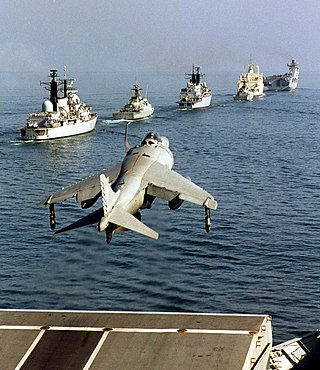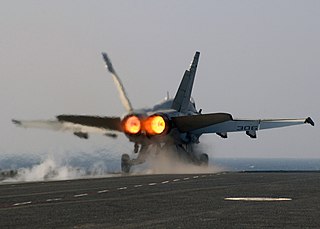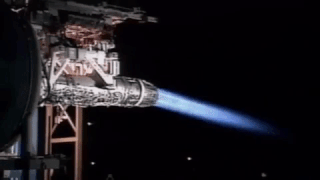
The Hawker Siddeley Harrier is a jet-powered attack aircraft designed and produced by the British aerospace company Hawker Siddeley. It was the first operational ground attack and reconnaissance aircraft with vertical/short takeoff and landing (V/STOL) capabilities and the only truly successful V/STOL design of that era.

A short take-off and vertical landing aircraft is a fixed-wing aircraft that is able to take off from a short runway and land vertically. The formal NATO definition is:
A Short Take-Off and Vertical Landing aircraft is a fixed-wing aircraft capable of clearing a 15 m obstacle within 450 m of commencing take-off run, and capable of landing vertically.
A vertical take-off and landing (VTOL) aircraft is one that can take off and land vertically without relying on a runway. This classification can include a variety of types of aircraft including helicopters as well as thrust-vectoring fixed-wing aircraft and other hybrid aircraft with powered rotors such as cyclogyros/cyclocopters and gyrodynes.

The British Aircraft Corporation TSR-2 is a cancelled Cold War strike and reconnaissance aircraft developed by the British Aircraft Corporation (BAC), for the Royal Air Force (RAF) in the late 1950s and early 1960s. The TSR-2 was designed around both conventional and nuclear weapons delivery: it was to penetrate well-defended frontline areas at low altitudes and very high speeds, and then attack high-value targets in rear areas. Another intended combat role was to provide high-altitude, high-speed stand-off, side-looking radar and photographic imagery and signals intelligence, aerial reconnaissance. Only one airframe flew and test flights and weight-rise during design indicated that the aircraft would be unable to meet its original stringent design specifications. The design specifications were reduced as the result of flight testing.

The Harrier, informally referred to as the Harrier jump jet, is a family of jet-powered attack aircraft capable of vertical/short takeoff and landing operations (V/STOL). Named after a bird of prey, it was originally developed by British manufacturer Hawker Siddeley in the 1960s. The Harrier emerged as the only truly successful V/STOL design of the many attempted during that era. It was conceived to operate from improvised bases, such as car parks or forest clearings, without requiring large and vulnerable air bases. Later, the design was adapted for use from aircraft carriers.

A vertical and/or short take-off and landing (V/STOL) aircraft is an airplane able to take-off or land vertically or on short runways. Vertical takeoff and landing (VTOL) aircraft are a subset of V/STOL craft that do not require runways at all. Generally, a V/STOL aircraft needs to be able to hover. Helicopters are not considered under the V/STOL classification as the classification is only used for aeroplanes, aircraft that achieve lift (force) in forward flight by planing the air, thereby achieving speed and fuel efficiency that is typically greater than the capability of helicopters.

An afterburner is an additional combustion component used on some jet engines, mostly those on military supersonic aircraft. Its purpose is to increase thrust, usually for supersonic flight, takeoff, and combat. The afterburning process injects additional fuel into a combustor in the jet pipe behind the turbine, "reheating" the exhaust gas. Afterburning significantly increases thrust as an alternative to using a bigger engine with its attendant weight penalty, but at the cost of increased fuel consumption which limits its use to short periods. This aircraft application of "reheat" contrasts with the meaning and implementation of "reheat" applicable to gas turbines driving electrical generators and which reduces fuel consumption.

The Rolls-Royce Pegasus, formerly the Bristol Siddeley Pegasus, is a British turbofan engine originally designed by Bristol Siddeley. It was manufactured by Rolls-Royce plc. The engine is not only able to power a jet aircraft forward, but also to direct thrust downwards via swivelling nozzles. Lightly loaded aircraft equipped with this engine can manoeuvre like a helicopter. In particular, they can perform vertical takeoffs and landings. In US service, the engine is designated F402.

Thrust vectoring, also known as thrust vector control (TVC), is the ability of an aircraft, rocket, or other vehicle to manipulate the direction of the thrust from its engine(s) or motor(s) to control the attitude or angular velocity of the vehicle.

The Yakovlev Yak-38 was Soviet Naval Aviation's only operational VTOL strike fighter aircraft in addition to being its first operational carrier-based fixed-wing aircraft. It was developed specifically for, and served almost exclusively on, the Kiev-class aircraft carriers.

The Yakovlev Yak-36, also known as Izdeliye V, is a Soviet technology demonstrator for a VTOL combat aircraft.

The Hawker P.1127 and the Hawker Siddeley Kestrel FGA.1 are the British experimental and development aircraft that led to the Hawker Siddeley Harrier, the first vertical and/or short take-off and landing (V/STOL) jet fighter-bomber.

The Dassault Mirage IIIV, also spelled Mirage III V, was a French vertical take-off and landing (VTOL) prototype fighter aircraft of the mid-1960s developed and produced by Dassault Aviation.

The Bristol Siddeley BS.100 is a British twin-spool, vectored thrust, turbofan aero engine that first ran in 1960. The engine was designed and built in limited numbers by Bristol Siddeley Engines Limited. The project was cancelled in early 1965.
The Hawker Siddeley P.1154 was a planned supersonic vertical/short take-off and landing (V/STOL) fighter aircraft designed by Hawker Siddeley Aviation (HSA).

The EWR VJ 101 was an experimental German jet fighter vertical takeoff/landing (VTOL) tiltjet aircraft. VJ stood for Versuchsjäger,. The 101 was one of the first V/STOL designs to have the potential for eventual Mach 2 flight.

The Rockwell XFV-12 was a prototype supersonic United States Navy fighter which was built in 1977. The XFV-12 design attempted to combine the Mach 2 speed and AIM-7 Sparrow armament of the McDonnell Douglas F-4 Phantom II in a VTOL fighter for the small Sea Control Ship which was under study at the time. On paper, it looked superior to the subsonic Hawker Siddeley Harrier attack fighter. However it was unable to demonstrate an untethered vertical takeoff and its inability to meet performance requirements terminated the program.

The Hawker P.1121 was a British supersonic fighter aircraft designed, but never fully completed, by Hawker Siddeley during the mid-1950s. It was designed by a team headed by Sir Sydney Camm.
Ralph Spenser Hooper, OBE, FREng, FRAeS was an English aeronautical engineer, recognised mostly for his work on the Hawker Siddeley Harrier, specifically in relation to the marriage between the Pegasus engine and the layout of the aircraft, allowing it to safely hover with margins of stability.

















